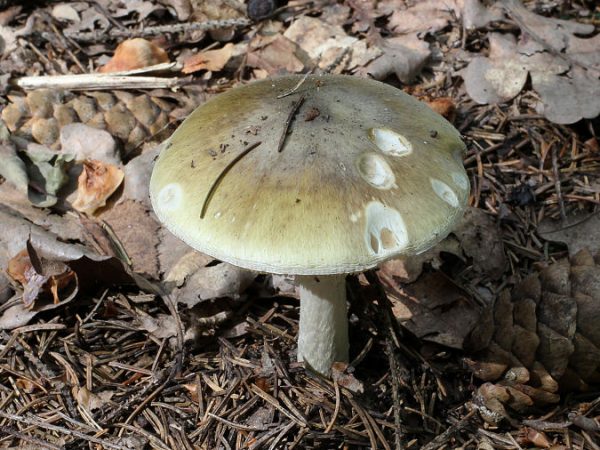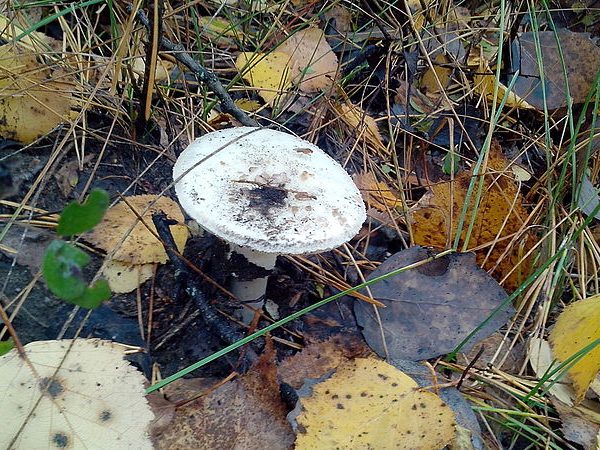Description of pale toadstool
The most toxic mushroom that grows in any conditions is the pale grebe belonging to the genus Amanita. Contains a deadly toxin - phalloidin, which makes all parts of it poisonous, including the mycelium. Toadstool poisoning is often fatal.

Description of pale toadstool
Description of toadstool
The poisonous mushroom pale toadstool belongs to the genus Amanita. Appears in forests in early June, after the first heavy rainfall, simultaneously with the first edible mushrooms. The largest increase in fruiting bodies of the species is observed in August-September.
Characteristics of the mushroom:
- the pale grebe grows in large families, on all types of soil;
- the species is very hygrophilous;
- the shape of the cap is round, diameter 8-14 cm;
- the color of the toadstool varies from milky white to olive, sometimes it is gray-green, the structure is smooth, sometimes it can be covered with white specks - the remnants of a common blanket, which are washed off by rain;
- the leg is snow-white, high (about 20 cm), in the lower part it expands significantly, forming a "tuber";
- lamellar geminophore.
According to the description, the cap of the pale toadstool is flat-convex. The plates located on the inside are white. On the cut, the flesh is slightly light green, almost white.
Pale toadstool is similar to edible mushrooms, it can be distinguished by its leg. At the top, at a distance of 2-3 cm from the cap, there is a film ring. At the bottom of the leg there is a cup (volva) - the remains of a common blanket. When a young fruiting body erupts, it is divided into 3-4 parts, located directly at the ground. For edible mushrooms, such rings on the stem are not typical.
The Volvo is not part of the leg, it looks like the mushroom is inserted into it.

On the leg of the toadstool, at a distance of 2-3 cm from the cap, there is a film ring
Similar species
The pale toadstool is characterized by the presence of mushrooms of the following categories similar in appearance to it:
Types of poisonous mushrooms similar in action to toadstool
Some of the poisonous species do not have Russian-language names, therefore, Latin ones are used:
- smelly fly agaric, or white toadstool;
- fly agaric bisporiger (in English - "destroyer angel");
- spring fly agaric;
- fly agaric okreata.
The genus Amanita includes an extensive list of fungi with the same traits. Caesarean mushroom is an edible fly agaric that can be easily confused with a poisonous twin. Caesarean mushrooms grow in early summer, appear abundantly after the first rains.
The group of edible mushrooms includes umbrellas: girlish, nutty and variegated, which are suitable for eating.
Types of toadstool-like edible mushrooms
The main danger is that pale toadstool looks like some edible mushrooms:
- green russula;
- champignon;
- greenfinch.
The description indicates that the smelly fly agaric species is the poisonous counterpart of the true pale toadstool. The green russula is characterized by a compacted stem structure. The hat is 14 cm, it gets shine in the heat.The skin color is green in the young specimen, brown in the old one. The main difference: the pale toadstool always has 2 rings on the leg (if I may say so): above and below, the russula does not have them.
The first mushrooms appear in parallel with toadstools. A pale toadstool looks like a young champignon. The edible adult champignon is distinguished by a semicircular white cap, which sits tightly on a thickened stem, on which there are no rings. To avoid poisoning, do not eat raw mushroom.
Greenfinches are dense in structure, green mushrooms. The mushroom legs are dense, brown. The main difference is that young green plants grow at a shallow depth in the surface layer of the soil. It can also be distinguished from edibles by their smell. Pale toadstool has an unpleasant odor, sweetish in old mushrooms and mild in young ones.

A pale toadstool looks like some edible mushroom
Properties and toxicity
The poisonous substance amanitin in the composition of the mushroom is a slow-acting poison. The second toxin of the pale toadstool is no less dangerous - phalloidin. Substance of a fast spectrum of action. Psilocybin mushrooms have a hallucinogenic effect. Toadstools grow everywhere, they can even be found in a private summer cottage, a lawn of a courtyard, in a vegetable garden and a closed greenhouse, if the spores were brought in by feet from the street.
Symptoms of pale toadstool poisoning can manifest themselves 24 hours after consumption.
If a person ate a poisonous pale toadstool and help was not provided immediately, then after 2-3 days of exposure to toxins, all organs refuse to him. The survivors are forced to be treated all their lives, feeling the consequences of the poisoning with the pale toadstool.
Symptoms of pale toadstool poisoning:
- signs of pale toadstool poisoning are absent for 12-48 hours;
- intoxication - an acute phase, accompanied by severe cuts in the abdomen, headache, vomiting, diarrhea, severe dehydration: the skin is blue, blood pressure is increased, muscles contract convulsively, dehydration (loss of water by the body) is pronounced;
- however, at this stage it is important to determine the degree of poisoning: if the content of the toxin in the blood is high, then the death occurs on the 3rd day;
- psilocybin substances cause hallucinations;
- if help was not provided within 3 days, complete destruction of all organs and systems occurs: people die from renal and hepatic failure.
Death can occur within 10 days of eating the pale toadstool. By the way. In the processed form, pale grebe is practically indistinguishable from edible mushrooms.
Irina Selyutina (Biologist):
To date, antidotes have not yet been developed to neutralize the toadstool poisons. If the poisoning was detected at an early stage in a medical facility to the victim:
- They give drugs from the benzylpenicillin group. Thanks to them, the effect of toxins on the body is reduced.
- A thorough cleaning of the gastrointestinal tract from the remnants of the mushroom mass is carried out in order to prevent the further spread of toxins throughout the body.
- Saline solution (0.85% NaCl solution) and glucose are introduced.
- For therapy, drugs that stabilize the work of the heart, kidneys and liver must be used. Blood thinning medications may also be needed.
- Active detoxification procedures are performed:
- hemosorption;
- plasma exchange;
- plasmapheresis.
For at least 10 days, the patient needs bed rest and a strict diet. The diet is based on jelly, stewed fruit, cereals in water and milk soups. The use of vegetable soups and rosehip decoctions is allowed. The portions should be small.
Fish, meat, raw vegetables and fruits should be excluded from the diet.
Interesting Facts: the toxin contained in its composition is partially useful, but not compatible with alcohol. An antidote is made from the mushroom, saving from poisoning with other poisonous mushrooms. While walking through the forest, you should not pick up unfamiliar mushrooms, information about which you have not studied.Even seasoned mushroom pickers often bring home instead of edible poisonous counterparts.

The poisonous substance amanitin in the composition of the mushroom is a slow-acting poison.
Application
In cooking
The consumption of pale toadstool is strictly prohibited. It is classified as a highly toxic species of mushrooms, but the edible amanita or cesarean mushroom is quite edible and has a pleasant taste.
It is used to prepare various culinary delights. It is not suitable for preparations for the winter. The broths taste like summer mushrooms broths. Their mushroom smell is weak.
Umbrellas - girlish, nutty and variegated - are mostly used for drying. Mushroom pickers claim that their caps have a piquant taste and pleasant aroma when dried.
In medicine
Lamellar types of mushrooms are actively used in folk medicine and non-traditional trends. For example, homeopaths prepare infusions from poisonous plants and mushrooms. They are sure that in small quantities, poison is a disproportionate benefit to the body. Traditional healers make tinctures.
Treatment with drugs of their poisons is dangerous. Before use, carefully read the instructions with the names of the substances included in the medicine. Do not start homeopathic treatment without consulting your doctor at a regular hospital.
Produced from pale toadstools and an antidote that neutralizes the poison of any variety of pale toadstools. The medicine is still unfinished and thousands of people die from poisoning every year. Lethal dose: 30 g. The only chance to escape is to seek help in time.
Interesting Facts
The pale green toadstool smells like the first spring mushrooms. In such cases, the only way to determine if the mushroom is poisonous or not is to show the alleged pale toadstool in the laboratory and conduct an analysis. There is a misconception that fly agarics are not wormy - some red worms live inside the mushroom and feed on its body.
Poisonous toadstool contains a huge amount of toxins that can kill even large animals weighing more than 150 kg.
There are folk ways to test mushrooms for toxicity. So, for example, it is believed that in a decoction of poisonous mushrooms, silver will turn black, but the first broth from any mushrooms collected in the forest has a black tint and silver in it can turn darker.
To get rid of toadstools, if they have grown in the garden, it is better to carefully, using protective gloves, collect the mushrooms, twisting them with the mycelium adjacent to the base of the leg and dispose of, having previously studied everything about the pale toadstool. Mycelium can also form with fruit trees.
You cannot shoot down poisonous mushrooms. So the spores will spread quickly, like parasites, and the fungi will occupy a large area.
Conclusion
Toadstools can be found in the forest, in any part of Russia. The venom of the pale toadstool is extremely toxic. It is equally dangerous to humans and animals. The biggest danger is that the clinical symptoms of poisoning appear in at least 12 hours. By this time, the poison has already spread throughout the body. It has the ability to destroy kidney, liver and heart cells. Many people died from poisoning with this mushroom.



